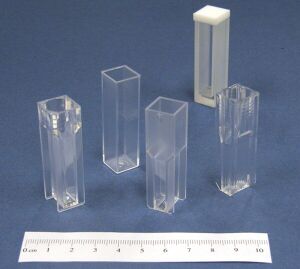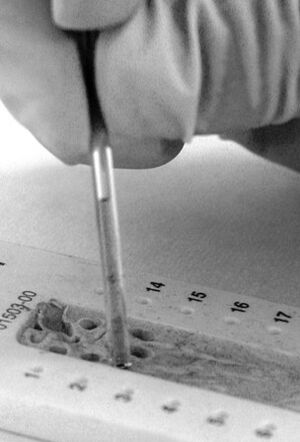Cuvette
A cuvette is a laboratory aid for measuring the optical properties of solutions.
Standard cuvettes with an optical path of 1 cm are most often used (rarely shorter – so-called ultra-microcuvettes for very small volumes of measured solutions). Cuvettes can be made of different materials and have different designs.
Cuvette Material[edit | edit source]
Cuvettes made of optical glass (usually labeled OG = optical glass, G = glass, etc.) are suitable for measurements in the visible part of the spectrum. For measurements in the UV range a cuvette made of quartz glass (Q = quartz, UV) must be used. Cuvettes made of special optical glasses (eg OS = Optisches Glas) are also available, which can usually be used for a wider part of the spectrum than conventional optical glass cuvettes, but are cheaper than quartz cuvettes. Measurement in cuvettes made of different types of glass is very accurate, with the right technique absorbance can be determined sample with accuracy up to four or five decimal places. However, the cuvettes are relatively expensive - optical glass costs hundreds to thousands of crowns, while the price of a normal quartz glass cuvette is around four to five thousand crowns. At the same time, the service life of cuvettes is limited, moreover, their maintenance is quite laborious. For these reasons, disposable plastic cuvettes are used for routine measurements, the price of which is usually only a few crowns, on the other hand, they can be reliably measured with an accuracy of only two to three decimal places (which is, however, fully satisfactory for most applications). They are mostly made from polystyrene (PS) – for the visible part of the spectrum, or from polymethyl methacrylate (PMMA) - also for part of the UV range.
Cuvette Dimensions[edit | edit source]
Today, standard spectrophotometric cuvettes (so-called macrocuvettes ) have internal dimensions of 1×1×3 to 4 cm and are filled to a volume of 3 ml (or less depending on the arrangement of the photometer and the height of the beam above the bottom of the cuvette). Due to the fact that we are working with smaller and smaller samples, semi-microcuvettes are used more and more often , which have a narrowed sample space and only need to fill them with about 0.8 ml of sample (again, it depends on the design of the device). Micro- and ultra-micro cuvettes are also available, which (sometimes at the cost of shortening the optical length) can also work with significantly smaller volumes (on the order of microliters). Because when semi-micro-, micro- and ultra-micro cuvettes are used in some spectrophotometers, a significant part of the light would pass through the glass around the sample, which would significantly increase the background and worsen the measurement accuracy, these cuvettes are often so-called masked – the glass around the sample area is blackened. On some cuvettes, the so-called cuvette factor is indicated - actually the actual optical length of the cuvette in cm. Ideally, the cuvette factor is equal to one, but it can vary due to manufacturing inaccuracies.
Special Cuvettes[edit | edit source]
Other types of cuvettes are used for special applications, e.g. flow cuvettes that can be connected to e.g. chromatography instruments, tempered cuvettes, spectrophotometric capillaries, etc.


